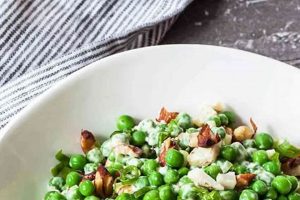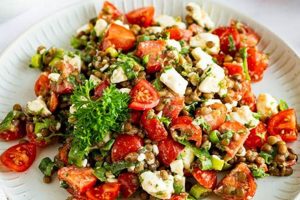This classic layered salad typically features a base of lettuce, followed by layers of peas, chopped vegetables (such as carrots, celery, and onions), bacon bits, hard-boiled eggs, shredded cheddar cheese, and a creamy dressing, often mayonnaise-based. Variations exist, incorporating ingredients like tomatoes, cucumbers, or different cheeses. A defining characteristic is its presentation, with the colorful layers distinctly visible in a glass bowl or serving dish.
The layered presentation offers an attractive and appealing dish, suitable for potlucks, picnics, and holiday gatherings. Its customizable nature allows for adjustments based on dietary preferences or available ingredients. The combination of fresh vegetables, protein, and creamy dressing creates a satisfying and flavorful profile. Its widespread popularity has contributed to numerous variations and adaptations over the years, solidifying its status as a staple dish.
This dish provides a convenient and enjoyable way to incorporate a variety of vegetables. The following sections will explore ingredient selection, preparation techniques, variations, and tips for creating a visually stunning and delicious layered salad.
Tips for a Successful Layered Salad
Creating a visually appealing and flavorful layered salad requires attention to detail and a few key techniques. The following tips offer guidance for optimal results.
Tip 1: Ingredient Preparation: Thoroughly chop vegetables into uniform sizes for even layering and consistent texture. Ensure all ingredients are dry to prevent excess moisture from accumulating between layers.
Tip 2: Layer Order: Begin with a sturdy base layer, such as lettuce or chopped romaine. Heavier ingredients, like peas and chopped vegetables, should be placed towards the bottom, while lighter ingredients, such as cheese and bacon bits, are better suited for the top layers. The dressing typically sits as the final layer or is served on the side.
Tip 3: Dressing Choice: Classic options include mayonnaise-based dressings. Consider lighter alternatives, such as vinaigrettes or yogurt-based dressings, for a healthier option. The dressing can also be layered within the salad to add flavor dimension or served on the side to prevent the salad from becoming soggy.
Tip 4: Storage: Assemble the salad close to serving time to maintain ingredient freshness and prevent the layers from becoming watery. If advance preparation is necessary, store the individual components separately and combine them just before serving.
Tip 5: Presentation: Utilize a clear glass bowl or serving dish to showcase the colorful layers. A spatula or large spoon assists in serving even portions of each layer. Garnishing with fresh herbs or a sprinkle of paprika can enhance visual appeal.
Tip 6: Customization: Adapt ingredient choices based on dietary restrictions or preferences. Substitute ingredients or add new elements, such as cooked chicken or different cheeses, to create unique flavor combinations.
Tip 7: Chilling: Chilling the salad for a short period before serving can enhance the flavors and create a refreshing element, especially during warmer months.
By following these tips, one can ensure a visually stunning and delicious layered salad that is sure to impress. Attention to ingredient preparation, layer order, and presentation contributes significantly to the overall success of this dish.
The following section will provide a sample recipe incorporating these techniques and demonstrating how to create a delightful layered salad experience.
1. Layered Construction
Layered construction is fundamental to this salad, contributing significantly to both its aesthetic appeal and flavor profile. The distinct layers, visible through a clear serving dish, create an enticing presentation, while the sequential arrangement of ingredients offers a varied taste experience with each bite. This construction method prevents flavors from muddling, allowing individual components to shine while contributing to the overall composition. For example, the crisp lettuce provides a refreshing contrast to the creamy dressing, while the crunch of bacon bits complements the soft textures of peas and hard-boiled eggs.
The structural integrity afforded by layered construction also offers practical advantages. Dense ingredients at the base, such as lettuce and peas, provide a foundation for more delicate items like shredded cheese and bacon bits. This prevents heavier ingredients from crushing lighter ones, maintaining both visual appeal and textural integrity. Furthermore, layering allows for portion control, ensuring an even distribution of ingredients throughout the salad. This is particularly beneficial in large servings intended for potlucks or gatherings, where consistent flavor and texture are desirable.
In conclusion, layered construction is integral to this salad’s identity, impacting presentation, flavor delivery, and structural integrity. Understanding this principle allows for successful replication and appreciation of the dish. This structured approach not only enhances the dining experience but also facilitates practical considerations like portioning and ingredient preservation. The visual and textural contrasts achieved through layering contribute to its continued popularity as a refreshing and satisfying dish.
2. Classic Ingredients
Classic ingredients define the traditional character of this layered salad. These components contribute not only to the established flavor profile but also to the cultural recognition and nostalgic appeal of the dish. Ingredients such as iceberg lettuce, peas, carrots, hard-boiled eggs, bacon bits, and cheddar cheese are frequently cited as core elements. These ingredients, readily available and familiar to many, contribute to the dish’s broad appeal and enduring popularity. Their combined flavors and textures create a balanced and satisfying culinary experience. For example, the crisp lettuce provides a refreshing counterpoint to the richness of the mayonnaise-based dressing, while the savory bacon bits complement the sweetness of the peas and carrots.
The selection of these classic ingredients often reflects practical considerations. Many of these components are shelf-stable or easily preserved, contributing to the dish’s suitability for potlucks and gatherings where advance preparation is common. The affordability and accessibility of these ingredients further enhance their suitability for large-scale preparation and serving. Moreover, the adaptability of these classic ingredients allows for regional and individual variations. Substitutions, such as using different types of lettuce or cheese, or incorporating regional favorites, demonstrate the flexibility of the recipe while retaining its fundamental character. This adaptability contributes to the widespread adoption and enduring presence of this salad in various culinary traditions.
Understanding the role of classic ingredients in this salad provides insights into its enduring appeal and adaptability. These ingredients offer a familiar flavor profile, contributing to the comfort and nostalgia associated with the dish. Their practicality and accessibility contribute to its continued popularity as a convenient and satisfying option for various occasions. Further exploration of these classic ingredients and their potential variations can lead to a deeper appreciation of the dish’s versatility and enduring presence in culinary culture.
3. Kraft Mayonnaise Dressing
Kraft mayonnaise dressing plays a significant role in the quintessential seven-layer salad experience. The creamy texture and tangy flavor of Kraft mayonnaise provide a unifying element, binding the diverse ingredients and contributing a richness that complements the fresh vegetables, crispy bacon, and sharp cheddar cheese. While homemade dressings or other commercial brands can be substituted, Kraft mayonnaise often holds a nostalgic association with this classic dish, contributing to its familiar flavor profile. This association stems from Kraft Foods’ prominent marketing and the widespread availability of their mayonnaise products, historically making it a convenient and accessible choice for home cooks. Recipes frequently specify Kraft mayonnaise, highlighting its perceived importance in achieving the desired taste and texture.
The specific qualities of Kraft mayonnaise influence the salad’s overall structure and flavor. Its viscosity contributes to the structural integrity of the layers, preventing them from collapsing or becoming overly watery. This allows the distinct colors and textures of each layer to remain visually appealing. The tangy flavor of Kraft mayonnaise balances the sweetness of peas and carrots, while also complementing the saltiness of the bacon and the sharpness of the cheddar cheese. This balance of flavors is crucial to the salad’s overall appeal. Furthermore, the emulsion stability of Kraft mayonnaise prevents the dressing from separating, ensuring a consistently creamy texture throughout the salad.
Understanding the role of Kraft mayonnaise extends beyond simply following a recipe. It provides insight into the historical and cultural context of the dish, as well as the practical considerations of ingredient selection. Awareness of the dressing’s functional properties, such as its viscosity and emulsion stability, allows for informed substitutions and adaptations. While variations certainly exist, recognizing the traditional association between Kraft mayonnaise and this specific salad offers valuable context for appreciating its classic presentation and flavor profile.
4. Customizable Variations
Customizable variations represent a key aspect of the seven-layer salad, contributing to its enduring popularity and adaptability. This inherent flexibility allows the salad to cater to diverse palates and dietary needs, transforming a classic recipe into a versatile platform for culinary creativity. Variations can range from simple ingredient substitutions to the incorporation of entirely new components, expanding the salad’s potential beyond its traditional form. For example, substituting turkey bacon for traditional pork bacon accommodates those observing dietary restrictions, while adding ingredients like avocado or black olives introduces new flavor profiles and textures.
The adaptability of the seven-layer salad extends beyond ingredient choices. Variations can also involve adjustments to the layering order or the dressing itself. Some individuals might prefer a lighter vinaigrette in place of the traditional mayonnaise-based dressing, while others might experiment with different layering sequences to achieve specific flavor combinations. The flexible nature of the recipe permits such modifications without compromising the fundamental concept of a layered salad. This adaptability allows the salad to be tailored to specific occasions and preferences, from a light luncheon dish to a hearty potluck contribution. The incorporation of seasonal ingredients provides another avenue for customization, further expanding the potential flavor profiles and aligning the salad with available produce.
In conclusion, customizable variations contribute significantly to the sustained relevance of the seven-layer salad in contemporary culinary practice. This inherent flexibility allows the dish to transcend its traditional form and adapt to evolving tastes and dietary preferences. Understanding the potential for customization empowers individuals to create personalized versions of this classic dish, ensuring its continued presence and enjoyment across generations and culinary traditions. This capacity for adaptation highlights the salad’s resilience and its potential to remain a staple dish for years to come.
5. Make-Ahead Convenience
Make-ahead convenience is a significant factor contributing to the popularity of the seven-layer salad, particularly for gatherings and events. The ability to prepare components in advance simplifies the overall process, reducing stress and allowing hosts to focus on other aspects of event preparation. This inherent convenience makes the salad a practical choice for potlucks, picnics, and holidays where time management is crucial.
- Component Pre-preparation:
Individual components, such as chopping vegetables, cooking bacon, and grating cheese, can be completed a day or two in advance. Storing these prepared ingredients separately maintains their freshness and prevents premature mixing, which could lead to sogginess or flavor degradation. This segmented preparation allows for efficient assembly closer to serving time.
- Layered Assembly Timing:
While individual components benefit from advance preparation, the final layering process is best performed shortly before serving. This preserves the crispness of the vegetables and prevents the dressing from making the other layers soggy. This timing strategy optimizes both flavor and texture, ensuring a satisfying culinary experience.
- Refrigeration and Storage:
Once assembled, the layered salad benefits from a brief period of refrigeration to allow the flavors to meld and the dish to chill. However, extended refrigeration can impact the texture of certain ingredients, particularly lettuce and bacon. Understanding these storage implications allows for optimal planning and timing to maintain quality and freshness.
- Transportation and Serving:
The layered salad’s structure lends itself well to transport, provided the container offers sufficient support to prevent shifting or collapsing. A clear, airtight container allows for easy visibility and maintains ingredient integrity during travel. These practical considerations further contribute to the salad’s suitability for potlucks and outdoor events.
The make-ahead convenience of the seven-layer salad significantly contributes to its practicality and appeal for various occasions. By understanding the optimal timing for component preparation, layering, and storage, one can maximize both the flavor and presentation of this classic dish while minimizing time constraints and stress associated with event planning. This inherent convenience, combined with its customizable nature, ensures the salad’s continued presence as a popular choice for gatherings and celebrations.
6. Crowd-pleasing presentation
Crowd-pleasing presentation forms an integral part of the appeal of the seven-layer salad. The visually distinct layers, often showcased in a transparent glass dish, create an immediate sense of anticipation and contribute significantly to the dish’s perceived value. This aesthetic appeal enhances the dining experience, transforming a simple salad into a centerpiece worthy of celebrations and gatherings. The vibrant colors of the individual layersthe green of the lettuce, the bright orange of the carrots, the stark white of the hard-boiled eggs, and the rich red of the tomatoes (if included)create a visually stimulating effect that draws the eye and entices the appetite. This visual appeal contributes to the salad’s popularity at potlucks and buffets, where dishes compete for attention.
The impact of presentation extends beyond mere aesthetics. The layered arrangement itself contributes to the overall enjoyment of the salad. Each bite offers a distinct combination of flavors and textures due to the structured layering, creating a more complex and satisfying culinary experience. This element of surprise and anticipation with each bite distinguishes the seven-layer salad from a traditional tossed salad, elevating it beyond simple sustenance to a more engaging culinary experience. Furthermore, the layered format allows for portion control and ensures an even distribution of ingredients, which is particularly important when serving large groups. This predictability contributes to the dish’s suitability for social gatherings, ensuring each guest receives a balanced and visually appealing serving.
In conclusion, the crowd-pleasing presentation of the seven-layer salad is essential to its enduring appeal. The visual impact of the layered ingredients creates a sense of occasion and elevates the dining experience. The structural arrangement contributes to both the enjoyment and practicality of the dish, making it a consistently popular choice for social gatherings. Recognizing the significance of presentation provides valuable insight into the enduring popularity of this classic dish and underscores the importance of visual appeal in culinary arts.
Frequently Asked Questions
This section addresses common inquiries regarding the preparation and variations of this layered salad, offering practical guidance for achieving optimal results.
Question 1: Can the salad be prepared the day before serving?
While individual components can be prepared in advance, assembling the salad too early can lead to sogginess. It is recommended to combine the layers shortly before serving to maintain the crispness of the vegetables and prevent the dressing from saturating the other ingredients.
Question 2: What type of lettuce is best suited for this salad?
Iceberg lettuce is traditionally used for its crisp texture and ability to hold up under the weight of the other layers. Romaine lettuce can also be used for a slightly more nutritious option, or a combination of lettuces for varied texture and flavor.
Question 3: Can different cheeses be used?
Cheddar cheese is the classic choice, but variations can include shredded Monterey Jack, Colby, or a blend of cheeses. Consider flavor compatibility with other ingredients when selecting alternatives.
Question 4: What are healthier dressing alternatives?
Substituting a lighter dressing, such as a vinaigrette or a yogurt-based dressing, reduces the overall calorie and fat content. A reduced-fat mayonnaise can also be considered.
Question 5: How can sogginess be prevented?
Ensuring all ingredients are dry before layering is crucial. Storing the dressing separately and adding it just before serving prevents premature saturation of the other layers.
Question 6: Can this salad be adapted for dietary restrictions?
Ingredient substitutions readily accommodate dietary restrictions. Using turkey bacon instead of pork bacon, or omitting certain ingredients entirely, allows for customization based on individual needs. Consulting ingredient labels ensures compliance with specific dietary guidelines.
Careful consideration of these frequently asked questions contributes to successful preparation and enjoyable consumption. Understanding the underlying principles of ingredient selection, layering techniques, and storage guidelines ensures a positive experience with this classic layered salad.
The subsequent section will provide a step-by-step recipe guide, incorporating the insights gleaned from these frequently asked questions and enabling practical application of the discussed techniques.
Kraft Seven Layer Salad Recipe
This exploration of the Kraft seven layer salad recipe has delved into its key components, from the classic ingredients and layered construction to the customizable variations and make-ahead convenience. The significance of Kraft mayonnaise dressing within the traditional context has been examined, along with practical tips for achieving optimal results. The impact of presentation on overall enjoyment has been highlighted, emphasizing the visual appeal that makes this salad a crowd-pleasing choice for gatherings and celebrations. Addressing frequently asked questions provides further guidance for successful preparation and adaptation to individual preferences and dietary needs.
The enduring popularity of this layered salad underscores its adaptability and enduring appeal. Its capacity for customization ensures relevance across diverse culinary traditions and dietary preferences. Continued exploration of ingredient variations and presentation techniques offers opportunities for personalized interpretations and innovative adaptations, solidifying the Kraft seven layer salad’s position as a timeless classic in the culinary landscape.






